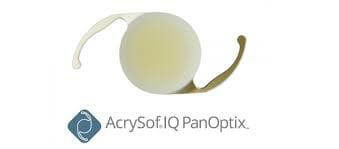PanOptix Trifocal IOL

Prior to FDA approval of presbyopia-correcting IOLs that correct vision for distance, intermediate, and/or near vision, IOLs were monofocal lenses that correct vision at one focal point – usually distance vision. Patients were required to wear glasses, bifocals, or trifocals for intermediate and near vision. Distance vision tasks include driving, outdoor activities, and watching TV. Intermediate vision tasks (about arms length) include computer work, painting, and applying makeup; near vision tasks include reading and sewing.
Multifocal IOLs have been available in the USA for many years now, and have allowed patients to reduce or eliminate their dependence on glasses. Prior to 2019, the multifocal lenses were primarily bifocal lenses; they could correct vision at distance and either reading or intermediate but generally not both. In 2019, the PanOptix IOL was approved by the FDA, making this the first trifocal lens available in the USA (the PanOptix lens has been available in other countries for many more years). The PanOptix lens is designed to correct the three most important focal points: distance, intermediate, and near (reading) vision, thereby allowing more patients to be spectacle-free. It is important to note that the PanOptix lens is not designed like trifocal or progressive bifocal glasses; The PanOptix IOL has multiple rings or zones of focus around the lens, so that the retina receives distance, intermediate, and near images all at once, and the brain determines what image the eye is focusing on.
While the PanOptix lens can reduce the need for glasses, there is no guarantee that every patient can eliminate glasses 100%, though the majority of patients can do so. The PanOptix lens will create halos around lights, and this will be noticeable with oncoming headlights while driving at night; while the halos are not bothersome for most patients, some patients may experience difficulty with night driving. Not every patient is a candidate for the PanOptix lens, and this lens is not recommended for patients with certain eye conditions including corneal scars and retinal problems such as macular degeneration, diabetic retinopathy, and macular pucker or epiretinal membrane.
Ask the doctors at Sierra Nevada Eye Center if you are a candidate for the PanOptix trifocal lens.
Vivity EDOF IOL
Monofocal IOLs correct vision at just one focal point, most commonly distance vision; patients corrected for distance vision with monofocal IOLs must use glasses, typically bifocals or trifocals, for intermediate vision tasks (such as computer work and applying makeup) and for near vision tasks (such as reading and sewing). Newer extended depth of focus (EDOF) IOLs “stretch out” the focal point from distance to intermediate vision, resulting in a wider range of vision and less need for glasses.
The Vivity lens from Alcon is an EDOF IOL that uses special “X-Wave” technology to provide intermediate through distance vision, thus reducing the need for glasses. Reading glasses will usually be required for reading typical print such as newspapers and magazines. While multifocal IOLs such as the PanOptix trifocal lens correct a greater range of vision, from near to distance, they also have more visual disturbances such as halos. One advantage of the Vivity lens is it has much less visual disturbances than multifocal IOLs. Also, while multifocal IOLs are not recommended for patients with certain eye conditions such as macular degeneration, the Vivity IOL can be used in most patients.
Ask the doctors at Sierra Nevada Eye Center if you are a candidate for the Vivity EDOF lens.




